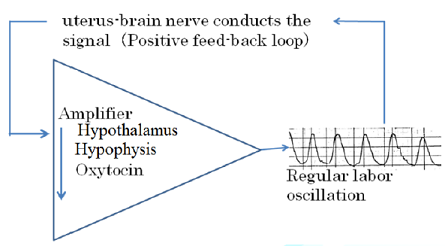Research Article :
Since reported uterine
contraction curves are uniform in intramyometrial pressure and external tocodynamometry,
and regular preterm labor contraction has been unable to be alleviated by
medicinal treatment to prolong the pregnancy duration until full term birth. The
clinical difficulty will be caused by no understanding of the process to
develop labor contraction, but thinking only to suppress uterine myometrial activity,
namely, labor contraction will develop by the coordination of a positive
feed-back system composed of the uterus, uterus-brain nerve, hypothalamus and
hypophysis which produce oxytocin to enhance uterine contraction until
physiological oscillation of whole feed-back system. As the myometrium is simple
compound of myomertrial cells which has no particular center of contraction
rhythm, but there is close similarity of contraction interval and the
contraction curves of intramyometrial pressure reported by Roberto
Caldeyro-Barcia 1958 in Monte-Video [1] and external tocodynamometry recorded
in 1980s in Tottori. Although there was no communication among two studies,
they were highly similar. As there was close similarity
between labor contraction recorded by Caldeyro-Barcia and enlarged ultrasound
oscillation (Figure 1), the author understood the mechanism of developing labor
contraction, namely, both curves are the result of oscillation, which is
produced by the presence of positive feed-back system, both in electric and physiologic
oscillations. Electric signal is enlarged in an
amplifier, of which output is fed back to the input of amplifier, and further
enlarged until saturation, where the frequency is constant according to the
frequency constant of the feed-back loop, and its amplitude is also. The electrical oscillation developed in a positive feed-back loop
composed of an amplifier, of which output is fed back to the input of amplifier
through the feed-back loop, of which time constant determines output wave
frequency. Signal amplitude is limited by the saturation of amplifier system,
then constant amplitude of constant frequency signal is produced after the
saturation of the feed-back system. Braxton-Hicks contraction is
after 30 weeks of pregnancy, while it does not proceed to the vaginal delivery,
is an example of incomplete uterine oscillation, namely, local early
contraction appears, while the positive feed-back system does not work to make
the contraction to regular labor contraction. That should be discussed in the
treatment of preterm labor, Tocolysis is common in the
preterm labor, while it is unable to stop the contraction to prolong the
pregnancy to full-term delivery. The author thinks that the preterm labor is a
complete uterine oscillation, which is difficult to stop with common tocolysis,
Therefore, it will be necessary to suppress the formation of positive feed-back
loop with any anesthesia of uterus-brain nerve, or to detect local uterine
contraction and suppress it by tocolysis, and so on, namely, more early stage
suppression will be effective, after detection of the early weak contraction
and tocolyzer is administered. Labor contraction of uterus is
developed by a positive feed-back system including brain until physiologic
oscillation. As preterm labor contraction develops by the same process, preterm
labor treatment will be started from the understanding of the oscillation of
positive feed-back system. 1.
Caldeyro-Barcia R, Poseiro JJ, Mendez-Bauer
C and Gulin LO. Effect of abnormal uterine contractions on fetal heart rate in
labor (1967) 9-27. 2.
Wiesel O, Toth IE, Boldokoi Z, Homyak A.
Bokor V, et al. Comparison of transsynaptic viral labeling of central nervous
system structures rom the uterine horn in virgin, pregnant, and lactating rats
(2004) Microsc Res Tech 63: 244-252. https://doi.org/10.1002/jemt.20034 3.
Yellon SM, Grushan LA, Rambau GM, Leshuga TJ and Kriby MA. Pregnancy-related changes in connections from the cervix to
forebrain and hypothalamus
in mice (2010) Reproduction 140: 155-164. https://doi.org/10.1530/REP-10-0002 4.
Gnanamanickam GJ and Liewellyn-Smith IJ.
Innervation of the rat uterus at esterus: a study in full-thickness,
immunoperoxidase-stained whole-mount preparations (2011) J Comp Neurol 519:
621-643. https://doi.org/10.1002/cne.22515 5.
Poletini MO, McKee DT, Szawa RE, Bertham
Richard, Helena CVV, et al. Cervical stimulation activates A1 and locus
coeruleus neurons that project to the paraventricular nucleus of hypothalamus
(2012) Brain Res Bull 88: 566-573.https://dx.doi.org/10.1016%2Fj.brainresbull.2012.06.004 Uterus; Labor contraction; Preterm labor;
Oscillation; Electric; Physiologic.Developing Process of Regular Labor Contraction
Kazuo Maeda
Abstract
Full-Text
Introduction
Methods
and Results

Figure 1: Uterine contractions are close to electric oscillation. A: Uterine contraction, Caldeyro-Barcia, 1960 [1]. B: Electric oscillation, 2MHz ultrasound, 1975.
The labor will be initiated by local and weak uterine contraction,
which is distributed whole uterus through the gap junction, the contraction
signal is conducted hypothalamus through the uterus-brain nerve [2-5] which
amplifies the signal then the hypophysis is stimulated to discharge oxytocin, which
further stimulates uterine contraction, and the positive feed-back loop is
further stimulated to saturate uterine contraction to constant intensity and
frequency, that is the physiologic oscillation (Figure 2).

Figure 2: Regular labor is physiologic oscillation caused by positive feed-back through uterus.Discussion
Conclusion
References
Keywords